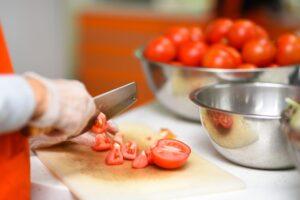Tomatoes, the versatile ingredient – preserve them safely with the recommendation of Nébih
Tomatoes are considered one of the most popular and versatile ingredients in gastronomy. Juicy tomatoes, which are abundant in the summer months, are not only a favorite ingredient in kitchens, but are also excellent for home preservation. Whether it is canning, drying or freezing, using the right methods is essential for food safety and quality preservation. The National Food Chain Safety Office (Nébih) Education Program has collected the most important information for the safe preservation of tomatoes.

(Photo: Pixabay)
Preserving tomatoes is easy for beginners to learn, but it is also worth taking the time for those more experienced in home canning – especially if the fresh produce is available in large quantities from your own garden at once.
Among the classic preservation methods, tomato juice and tomato puree are the most common
For canning, choose ripe, healthy, undamaged tomatoes. Wash the tomatoes thoroughly, remove the seeds, chop them, puree them, then cook them to a thick sauce or juice consistency, adding salt and/or a little sugar to taste. Then fill them into sterilized jars, making sure that no air bubbles remain in the jars. Seal the jars airtight, then heat them in a water bath at at least 80-90°C for 30-40 minutes for safe preservation. Heat treatment kills microorganisms, so the finished product can be stored for a long time without deteriorating its quality or making it risky to consume.
For tomato sauce, pureeing and canning, fleshier varieties with few seeds and a lower water content are best
For example, San Marzano varieties, which are elongated, Italian-style tomatoes, are a good choice, but classic canning tomatoes, which are oval and fleshy, can also be a good choice. For making tomato juice and drinking juice, large-berry fleshy tomatoes or ox heart tomatoes can be suitable The simplest and safest method for making dried tomatoes is to dry them in the oven (80-90°C, 10-12 hours), then store them in an airtight container in a cool, dark place. A popular version is dried tomatoes in oil, which requires special attention: in an oxygen-free environment, the Clostridium botulinum bacteria can multiply, which can cause botulism. In the case of dried tomatoes in oil, it is particularly important to use only completely dried tomatoes and to acidify the tomatoes in vinegar water beforehand, thus reducing the pH of the finished product. Store the finished product in the refrigerator and consume within 1-2 weeks. If you notice any suspicious signs (unpleasant smell, bubbles, opalescent oil), do not consume the product. For making dried tomatoes, smaller, more compact varieties are best, which contain little water, such as Principe Borghese. In addition, small oblong, brownish “plum tomatoes” of the continuous type are also low in juice and can be dried easily.
It is important to know that it is not recommended to consume unripe, still green tomatoes raw in large quantities
Unripe tomatoes contain solanine, a natural toxin that, however, in large quantities causes stomach upset and headaches. At the same time, spicy sauces or fried tomatoes can also be made from unripe tomatoes, as the amount of glycoalkaloids decreases with heat treatment. Whatever variety of tomato and preservation method you choose, knowing the correct methods is essential to ensure that they are safe on your table all year round.
Nébih
Related news
Authorities seize expired gyro meat in Budapest: inspections tighten in the street food sector
🎧 Hallgasd a cikket: Lejátszás Szünet Folytatás Leállítás Nyelv: Auto…
Read more >Safe holiday preparations: food safety tips for your Christmas menu
🎧 Hallgasd a cikket: Lejátszás Szünet Folytatás Leállítás Nyelv: Auto…
Read more >AM: Government helps farmers with a loan moratorium
🎧 Hallgasd a cikket: Lejátszás Szünet Folytatás Leállítás Nyelv: Auto…
Read more >Related news
New Year’s Eve: shortened opening hours in stores – general store closure on January 1
🎧 Hallgasd a cikket: Lejátszás Szünet Folytatás Leállítás Nyelv: Auto…
Read more >Tejföl is only a name for live flora: new categories for sour dairy products will be introduced from 2026
🎧 Hallgasd a cikket: Lejátszás Szünet Folytatás Leállítás Nyelv: Auto…
Read more >Sausage prices before New Year’s Eve: cheap entry, expensive premium – how big is the gap on the shelves?
🎧 Hallgasd a cikket: Lejátszás Szünet Folytatás Leállítás Nyelv: Auto…
Read more >






